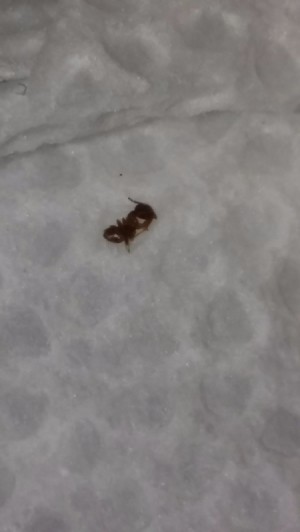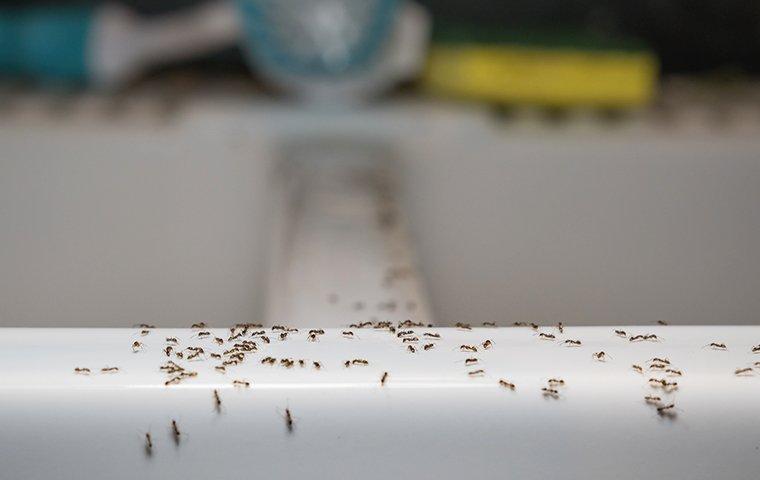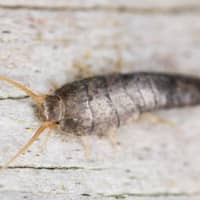Identifying the Intruders: What Are These Tiny Brown Bugs?
When I first noticed tiny brown bugs in my kitchen sink, I was puzzled and alarmed. These uninvited guests appeared out of nowhere, crawling around the sink and countertops. After some research and close observation, I identified them as drain flies, sink or moth flies. These small insects, measuring about 1/8 inch long, have fuzzy bodies and wings, giving them a moth-like appearance.
Drain flies thrive in damp, dark environments, making the kitchen sink an ideal habitat. They lay their eggs in the organic matter that accumulates in drains, such as food particles, grease, and soap scum. This debris provides a rich breeding ground for the larvae, which hatch and continue the cycle. Understanding what these bugs are and why they appear is the first step in tackling the problem.

Aside from drain flies, other tiny brown bugs can also invade the kitchen sink. Fruit flies, which are attracted to overripe fruits and sugary substances, can also make their way to the sink. Additionally, gnats, which are small flying insects, might be present if there’s excess moisture. Each of these pests has specific characteristics and habits, making identification crucial for effective treatment.
To properly identify the tiny brown bugs in your kitchen sink, closely observe their appearance and behavior. Drain flies are distinct with their fuzzy wings and slow, erratic flight patterns. Fruit flies are more agile and tend to hover around decaying fruits and vegetables. Gnats are tiny, slender, and often found near moist areas. Knowing the type of pest you’re dealing with will help you choose the most appropriate elimination method.
Once I identified the bugs in my kitchen sink as drain flies, I focused on understanding their life cycle. Drain flies go through four stages: egg, larva, pupa, and adult. The eggs hatch into larvae within 48 hours, and the larvae feed on organic matter in the drain for about 9 to 15 days. After pupating for 1 to 3 days, adult flies emerge, ready to continue the cycle. This rapid reproduction means that even a small infestation can quickly become a larger problem if not addressed promptly.
Identifying the source of the infestation is also crucial. In my case, I discovered that the bugs were breeding in the sink drain, but other possible sources include garbage disposals, floor drains, and any other area with standing water or decaying organic matter. Conducting a thorough inspection of these areas can help pinpoint the breeding sites and inform your pest control strategy.

Cleaning and Maintenance: The First Line of Defense
Once I knew what I was dealing with, the next step was to clean and maintain my kitchen sink and surrounding areas to prevent further infestations. Proper cleaning is essential to remove the organic matter that serves as a breeding ground for these bugs. I started by scrubbing the sink, drain, and any other affected areas with a stiff brush and a mixture of hot water and dish soap. This helped dislodge any debris and larvae that were clinging to the surfaces.
After the initial scrubbing, I poured boiling water down the drain to kill any remaining larvae and eggs. This simple yet effective method can be repeated daily until the infestation is under control. Boiling water not only kills the pests but also helps dissolve grease and other organic matter that might be stuck in the drain.
In addition to regular cleaning, I used a mixture of baking soda and vinegar to clean the drain. I poured half a cup of baking soda down the drain, followed by half a cup of vinegar. The chemical reaction between the two ingredients creates a fizzy foam that helps break down organic matter and disinfect the drain. After letting the mixture sit for about 15 minutes, I flushed the drain with hot water to rinse away any remaining residue.

Maintaining a dry environment is crucial in preventing future infestations. I made sure to wipe down the sink and countertops after each use to remove any excess moisture. Using a sink strainer to catch food particles and disposing of them properly also helps reduce the amount of organic matter that can accumulate in the drain.
Regularly inspecting and cleaning other potential breeding sites, such as garbage disposals and floor drains, is also important. I found that using a drain cleaner specifically designed to break down organic matter can be an effective preventive measure. These products contain enzymes or bacteria that consume organic debris, helping keep the drains clean and reducing the likelihood of infestations.
To further protect my kitchen, I made it a habit to take out the trash regularly and clean the trash cans with a disinfectant. This prevents any decaying organic matter from attracting pests. Additionally, I ensured that all food items were stored in sealed containers to avoid attracting fruit flies and other insects.

Natural Remedies: A Chemical-Free Approach
While cleaning and maintenance are essential, I also explored natural remedies to tackle the tiny brown bugs in my kitchen sink. These methods are not only effective but also safe for the environment and my family. One of the first remedies I tried was a mixture of apple cider vinegar and dish soap. I filled a small bowl with apple cider vinegar and added a few drops of dish soap. The vinegar attracts the flies, while the dish soap breaks the surface tension, causing the flies to drown.
Another natural remedy that worked for me was using a homemade fly trap. I fashioned a cone out of paper and placed it in a jar filled with a bit of apple cider vinegar or a piece of overripe fruit. The flies are drawn to the bait, enter the jar through the cone, and become trapped inside. This simple yet effective trap helped reduce the number of flies in my kitchen.
Essential oils can also be a powerful tool in repelling pests. I found that peppermint oil, in particular, is effective against drain flies. I mixed a few drops of peppermint oil with water in a spray bottle and sprayed the solution around the sink, drain, and other areas where the flies were present. The strong scent of peppermint repels the flies and prevents them from laying eggs.

Another essential oil I used was eucalyptus oil. Like peppermint, eucalyptus has a strong aroma that deters pests. I added a few drops of eucalyptus oil to a cotton ball and placed it near the sink and drain. This method helped keep the flies at bay and provided a pleasant fragrance in my kitchen.
In addition to essential oils, I discovered that diatomaceous earth is an effective natural insecticide. Diatomaceous earth is a fine powder made from fossilized algae and works by dehydrating insects. I sprinkled a small amount of food-grade diatomaceous earth around the sink and in the drain. The powder clings to the insects’ bodies, causing them to dry out and die.
Lastly, I tried using citrus peels to repel the flies. The strong scent of citrus is unpleasant to many insects. I placed lemon or orange peels around the sink and rubbed them on the drain and countertops. Not only did this method help repel the bugs, but it also left my kitchen smelling fresh and clean.

Chemical Solutions: When Natural Remedies Aren’t Enough
Despite my best efforts with natural remedies, I found that the infestation persisted. In cases where natural methods aren’t sufficient, chemical solutions can be an effective alternative. I began by using a commercial drain cleaner specifically designed to eliminate drain flies. These products contain powerful ingredients that break down organic matter and kill larvae and adult flies on contact.
It’s important to follow the manufacturer’s instructions carefully when using chemical drain cleaners. I poured the recommended amount down the drain and allowed it to sit for the specified time before flushing with hot water. Repeating this process as needed helped ensure that all stages of the flies’ life cycle were addressed.
In addition to drain cleaners, I used an insect growth regulator (IGR) spray. IGRs work by disrupting the development of insects, preventing them from reaching maturity and reproducing. I sprayed the IGR around the sink, drain, and other areas where the flies were present. This method helped break the breeding cycle and gradually reduced the population of drain flies.

Another effective chemical solution I tried was an aerosol insecticide. These products can be used to target adult flies directly. I sprayed the insecticide around the sink, paying close attention to cracks and crevices where the flies might hide. Using an aerosol insecticide in combination with other treatments helped quickly reduce the number of adult flies in my kitchen.
To complement these treatments, I also used a residual insecticide. Residual insecticides leave a long-lasting chemical barrier that continues to kill insects for weeks or even months. I applied the residual insecticide around the sink, drain, and other potential entry points. This method provided ongoing protection against re-infestation.
While using chemical solutions, it’s essential to take safety precautions. I made sure to wear gloves and a mask to avoid direct contact with the chemicals. Proper ventilation is also crucial, so I opened windows and doors to ensure good airflow while applying the treatments.
After successfully eliminating the infestation, I continued to use preventive measures to avoid future problems. Regular cleaning, maintenance, and occasional use of chemical treatments as needed helped keep my kitchen free of tiny brown bugs.

Preventive Measures: Keeping the Bugs at Bay
With the infestation under control, my focus shifted to preventing future occurrences of tiny brown bugs in my kitchen sink. Prevention is key to maintaining a pest-free environment, and there are several strategies I implemented to keep these bugs at bay.
Firstly, maintaining a clean and dry kitchen is essential. I made it a habit to clean the sink, countertops, and drains regularly. Using a sink strainer helps catch food particles and prevents them from going down the drain. I also made sure to dispose of food waste properly and take out the trash regularly to reduce potential breeding grounds.
Proper food storage is another critical preventive measure. I ensured that all food items, especially fruits and vegetables, were stored in sealed containers. This helps prevent fruit flies and other pests from being attracted to exposed food. Additionally, keeping pantry items such as grains, flour, and sugar in airtight containers prevents contamination by pantry pests.
Fixing leaks and addressing moisture issues is also important. I checked for any leaks under the sink and around the kitchen and repaired them promptly. Using a dehumidifier or ensuring proper ventilation in the kitchen helps reduce excess moisture, making the environment less attractive to pests.
Regularly inspecting and cleaning drains and garbage disposals can prevent organic matter from accumulating. I continued to use the baking soda and vinegar method periodically to keep the drains clean. Additionally, using a drain cleaner designed to break down organic debris on a regular basis helps maintain a clean and pest-free environment.
Sealing cracks and crevices around the kitchen can also prevent pests from entering. I used caulk to seal any gaps around the sink, countertops, and baseboards. This not only keeps insects out but also prevents moisture from getting trapped in these areas, reducing the likelihood of infestations.
Lastly, being vigilant and proactive is key to preventing pest problems. Regularly inspecting the kitchen for signs of pests, such as tiny brown bugs or droppings, allows for early detection and prompt action. By staying on top of cleaning and maintenance routines, I was able to keep my kitchen free of unwanted pests.

Professional Help: Knowing When to Call an Expert
Despite my best efforts, there may be situations where professional help is necessary to completely eradicate the infestation. If the problem persists or worsens despite using natural and chemical methods, calling a pest control expert can be the most effective solution.
Professional pest control companies have the expertise and tools to handle severe infestations. They can accurately identify the type of pest and determine the extent of the infestation. Based on their findings, they can recommend and implement the most effective treatment plan.
One of the benefits of hiring a professional is their access to specialized products and equipment. Pest control experts have access to stronger and more effective chemicals that are not available to the general public. These products can provide a more thorough and long-lasting solution to the infestation.
Additionally, professionals can offer advice on preventive measures and maintenance practices to avoid future infestations. They can identify potential problem areas and recommend solutions to keep the kitchen pest-free. This guidance can be invaluable in maintaining a clean and pest-free environment.
When choosing a pest control company, it’s important to select a reputable and experienced provider. Reading reviews, asking for recommendations, and verifying credentials can help ensure that you choose a reliable and effective service. A professional company should be willing to explain their treatment methods and answer any questions you may have.
In my experience, calling a professional was a game-changer. They quickly and effectively addressed the infestation, providing peace of mind and restoring my kitchen to a clean and bug-free state. While DIY methods can be effective, there are times when professional intervention is the best course of action.

What causes tiny brown bugs to appear in my kitchen sink?
Tiny brown bugs, such as drain flies, fruit flies, or gnats, appear in your kitchen sink primarily due to the presence of organic matter and moisture. These pests are attracted to the food particles, grease, and other debris that accumulate in drains. The damp environment provides an ideal breeding ground for these bugs. Regular cleaning and maintenance can help prevent their appearance.
How can I get rid of tiny brown bugs in my kitchen sink naturally?
Natural remedies can be effective in eliminating tiny brown bugs in your kitchen sink. Methods such as using a mixture of apple cider vinegar and dish soap, setting up homemade fly traps, and using essential oils like peppermint or eucalyptus can repel and trap these pests. Regular cleaning with baking soda and vinegar, combined with maintaining a dry environment, can also help control and prevent infestations.
Are chemical solutions safe to use for getting rid of these bugs?
Chemical solutions can be effective but should be used with caution. It’s important to follow the manufacturer’s instructions and take safety precautions, such as wearing gloves and ensuring proper ventilation. While chemical drain cleaners and insecticides can provide quick results, they should be used in combination with thorough cleaning and preventive measures for long-term success. If you have concerns about safety, consulting a professional pest control service is advisable.
How can I prevent tiny brown bugs from returning to my kitchen sink?
Preventing the return of tiny brown bugs involves maintaining a clean and dry kitchen environment. Regularly clean the sink, drains, and garbage disposals to remove organic matter. Use sink strainers to catch food particles and dispose of them properly. Store food items in sealed containers, fix any leaks, and ensure proper ventilation to reduce moisture. Sealing cracks and crevices and using preventive treatments can also help keep the bugs at bay.
When should I consider calling a professional for help?
If you have tried natural and chemical methods without success, or if the infestation is severe, it’s time to call a professional pest control service. Professionals have the expertise, tools, and access to stronger treatments to effectively handle infestations. They can accurately identify the pest, assess the extent of the infestation, and implement a comprehensive treatment plan. Additionally, they can provide advice on preventive measures to avoid future problems.
Can these bugs pose any health risks?
While tiny brown bugs like drain flies and fruit flies are generally not harmful, they can be a nuisance and indicate poor sanitation. However, their presence can sometimes signal underlying issues, such as mold or bacteria in drains, which can pose health risks. Maintaining a clean and pest-free kitchen is important for overall hygiene and can prevent potential health concerns. If you have any health-related worries, consulting a pest control expert or a healthcare professional is advisable.

Related Posts: